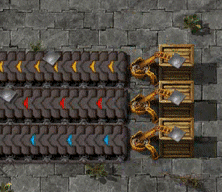Transport belts: Difference between revisions
(added picture) |
m (changed pic position) |
||
| Line 5: | Line 5: | ||
==Types== | ==Types== | ||
[[File:Transport_belts_speed.gif| | [[File:Transport_belts_speed.gif|thumb]] | ||
{| class="wikitable" | {| class="wikitable" | ||
|- | |- | ||
Revision as of 08:45, 18 December 2015
Transport belts are items which are used to transport items from one place to another. There are three types of transport belts, each with their own properties.
Types
| Type | Max. throughput (Items per game-second) | Speed (Tiles per game-second) | Max. density (Items per tile) | Required technologies |
|---|---|---|---|---|
| Basic transport belt | 13.393* | 1.875* | 7.144* | none |
| Fast transport belt | 26.786* | 3.749* | 7.144* | Logistics 2 |
| Express transport belt | 40.179* | 5.624* | 7.144* | Logistics 3 |
*experimental value: See Transport belt experiments for more detailed information.
Basic
Task: make a steady flow of items from your Mining drills to the Furnaces.
- Select a belt by taking a Storages/Stack from your Inventory
- Rotate the belt by pressing "R" until it faces the right direction.
- Place the belt (by default left mouse)
- Move in the direction you want the belt to go, and hold down the left mouse button: the belt continues to be placed.
In-place-replacement
If you have placed a belt in the wrong direction you don't need to dismantle it.
- Make sure your game-hand is empty and then simply press 'R' over the piece and it will change on the spot.
- This in-place-replacement is also possible with other belt-types. Pick up a faster belt type and place it over the current: The belt is picked up and replaced with that in your hand.
- Many more things can be in-place-replaced: Poles, Chests, Inserters, Assemblies, Furnaces...
Advanced
- For a more advanced introduction into the belt mechanics see the Belt transport system page.
- For information about the finer aspects of handling belts try the page on Transport Belt physics.
Turns and bends
Turns will always keep the alignment of items.
Belt Lanes: using two sides
Belts have two lanes that can be used for transporting. This allows for either a double flow of one material, or with some careful setup, transporting two different materials on the same belt.
Speed, Density and Throughput: About finding the bottlenecks
This is a mistake often made - even by advanced players. But first we need to introduce some definitions:
- Speed
- How fast does a belt move. This influences of course the throughput. The speed is easy to calculate: Basic transport belt is the slowest, the Fast transport belt is twice as fast as the basic and the Express transport belt is 3x the speed of basic.
- Density
- How tight are the items put on the belts. See Transport belts/Optimizing for tips, how to keep the density as tight as possible. See Transport belts/Physics about how dense you can put the items on the belts.
- Throughput
- This is speed * density. The maximum density on all belts are nearly equal (indeed the density on faster belts is lower, see Transport Belt physics).
This formula
Throughput = Speed * density
gives you two opportunities to enhance the throughput:
- More speed
- more density.
More speed is expensive (see optimizing with parallel belts), so more density is in many cases much easier to obtain. The way is in most cases, to find the bottleneck.
The bottleneck can be seen quite easy, if there is a part of a belt, where the items sometimes stop or don't move (or don't move fast) at maximum density and suddenly they come to a point, where this "stop and go" releases itself and they run free and are not so tight on the belt. This is in most cases the exact place, where you need to optimize your belts. It doesn't make sense to optimize much before or after this point, because if you fix it, you will find the next bottleneck anywhere else.
Side inserts (Crossings)
When belts join together at a t-junction, items are inserted from the side and they stay on the side of the belt they came from.
Lane Mixer (Mixing both sides of a belt into one)
Mixing of two lanes into one is depended on the fact, that you cannot really controll, how the mixing with the splitter works:
Without usage of underground belts:
With usage of underground belts:
A third type of mixing is by using the different speeds of the belts. A basic belt as input and put this into an express belt.
vv
vv
vv <-- this belt needs to be basic belt!
>>>>>>>>>>>>
^
| This belt needs to be express belt!
All other belts needs to be fast belts!
The result is, that if the output belt is not jammed, then the both input lanes are guaranteed to be mixed 1:1.
See also
- Transport network
- Transport
- Crafting network
- Logistic network
- Intersection with 4 belts from every side
- Transport belts/Transport other entities: even the car can be transported with belts.
- Why do belts not require power?: Some reasons...
- Transport belts/Speedup Walking: Walk/run in belt direction add the speed of the belt to your own.
- Transport belts/Defense: Use the Express belt to slow down the enemies
- Transport belts/Physics
- Transport belts/Turns
- Transport belts/Blocking items
- Transport belts/Side insert
- Transport belt Optimising
- Transport belts/Side insert
- Throughput and bottlenecks.
- Speed, Distance, Throughput, Compression
- Tutorial for Belt Speed, Density and Throughput
- Transport belts/Belt lane for more about usage of the two lanes of a belt.
- Transport belt Optimising
- Transport belts/Turns for details about turns.
- Transport belt Optimising about other ways to speed up this bottleneck.
- Testing fast belt corners (interesting video)
